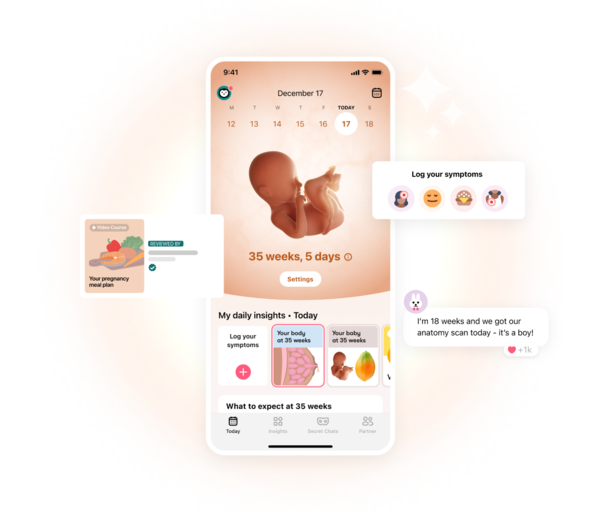Your body undergoes various changes during and after pregnancy to support the life of the fetus and newborn baby — and your breasts are no exception.
-
Tracking cycle
-
Getting pregnant
-
Pregnancy
-
Help Center
-
Flo for Partners
-
Anonymous Mode
-
Flo app reviews
-
Flo Premium New
-
Secret Chats New
-
Symptom Checker New
-
Your cycle
-
Health 360°
-
Getting pregnant
-
Pregnancy
-
Being a mom
-
LGBTQ+
-
Quizzes
-
Ovulation calculator
-
hCG calculator
-
Pregnancy test calculator
-
Menstrual cycle calculator
-
Period calculator
-
Implantation calculator
-
Pregnancy weeks to months calculator
-
Pregnancy due date calculator
-
IVF and FET due date calculator
-
Due date calculator by ultrasound
-
Medical Affairs
-
Science & Research
-
Pass It On Project New
-
Privacy Portal
-
Press Center
-
Flo Accuracy
-
Careers
-
Contact Us
Breasts Before and After Pregnancy: What to Expect


Every piece of content at Flo Health adheres to the highest editorial standards for language, style, and medical accuracy. To learn what we do to deliver the best health and lifestyle insights to you, check out our content review principles.
Anatomy of the breasts
Generally, breasts before and after pregnancy experience changes of all kinds. It’s not uncommon for a pregnant person to wonder what exactly the variances between boobs before and after pregnancy will be.
The main function of breasts is to produce breast milk, providing nutrition to newborns. Cooper suspensory ligaments help support each breast.
The breast consists of glandular tissue (which produces milk) and adipose tissue. Their proportion is individual and varies from person to person. As a person ages, their glandular tissue decreases in size. The breast is divided into segments containing mammary glands that consist of 20 to 40 lobules, which empty into special ducts that open individually into the nipple.
Lobules and ducts conduct milk from the mother to the baby — with the right hormonal stimulation.
Nipples also come in all shapes and sizes. Flat, short, or inverted nipples can affect breastfeeding. In most cases, the nipple must be at least seven millimeters long for successful breastfeeding.
The breasts’ fatty tissue is influenced by the hormone estrogen. As estrogen levels rise during puberty, they cause breasts to develop.
The breast undergoes significant changes during pregnancy, specifically to prepare for lactation.
But what exactly is going on with breast growth during pregnancy? Do your breasts stay large after pregnancy? Is there a way to prevent saggy breasts after pregnancy?
The fact is that changes will occur. Your breasts will grow during pregnancy, and yes, there are ways to prevent saggy breasts after pregnancy. Let’s explore these variances in more detail.
Breast changes during pregnancy
Breast growth during pregnancy is a key part of the process, as the body is undergoing changes to supply the newborn with milk. Breast changes begin in the first trimester when the amount of fatty tissue decreases. The duct system branches out noticeably, and the structure of the breast shifts.
From weeks 12–16 of pregnancy, the components of the gland are developed enough to begin producing colostrum. This yellowish-white liquid — also called the “first milk” — is released from the nipples. At this time, products like breast pads can prevent this fluid from leaking on your clothes.
Your nipples may darken, appear bigger, and begin to stick out due to hormonal changes throughout your pregnancy. They also may become more sensitive than before.
Increased blood flow may also make the veins in your breasts appear darker. Some people with breast growth during pregnancy may notice stretch marks appearing. This happens due to the quick growth of the breasts and is influenced by genetic and hormonal factors.
The body also boosts the production of estrogen and progesterone, especially at the beginning of your pregnancy. Progesterone drives the growth of the milk glands, while estrogen causes the milk ducts to develop. Folks typically experience significant breast growth during pregnancy in the first trimester — sometimes by two cup sizes or more.
Breast tenderness usually tapers midway through pregnancy. However, every pregnancy is different. People may experience breast tenderness changes in different ways. Some people may also notice their Montgomery glands — the small bumps on the nipples — becoming more noticeable during this time.
The milk glands can continue to contribute to breast growth during pregnancy until delivery.
Breasts after pregnancy
Your breasts after pregnancy receive signals from the hormone prolactin; immediately after birth, estrogen and progesterone levels fall. Prolactin causes the breasts to begin making milk. Your baby’s sucking or crying may also stimulate milk production. It typically takes a couple of days or more for the body to produce milk. In the meantime, your baby breastfeeds and receives colostrum, the milk precursor we mentioned earlier.
The breasts become larger between three and five days after giving birth. This happens due to lymphatic fluid that builds up in the vessels of the breast. By this time, milk is being actively produced and filling the ducts.
For many new parents, feeling comfortable with breastfeeding takes time. If choosing a comfortable position for you and your baby is posing a problem, discuss it with your health care provider.
Common issues may also affect the breasts after pregnancy. If your newborn does not attach to the whole areola, your nipple may become sore or cracked. This can occur when using a breast pump. If you develop any discomfort, seek advice from your health care provider.
Breast engorgement is a common postpartum condition and happens when the breasts overfill with milk. Your body is adjusting to the demands of producing milk, and any pain or tenderness can be alleviated by breastfeeding or using a breast pump.
Blocked milk ducts due to compression or a sudden decrease in feedings may cause further issues. These small but painful lumps can be prevented by massage, switching positions when feeding, and avoiding wearing tight-fitted clothing.
Exclusive breastfeeding is recommended for up to six months of your newborn's life and can be continued if you both wish. When and how to stop breastfeeding will vary based on each person’s lifestyle and goals. Once your little one has weaned, your nipples and breasts may return to their previous size, and your body will absorb the remaining milk.
Body weight is another factor that influences whether your breasts will return to their pre-breastfeeding size. It’s perfectly normal if your weight after pregnancy is different than before, and increased breast size can influence this.
How to maintain breast size after pregnancy

Breasts come in all shapes and sizes, and many people experience sagginess or decreased volume in their breasts after pregnancy. This may lead some to ask how to keep your breasts’ volume after pregnancy.
Here are some helpful tips:
- Breastfeed your baby. Unless your health care provider says otherwise, breastfeeding is always a healthy choice.
- Slow weight loss after childbirth. Most people need 2,000 to 2,500 kcal/day. This caloric requirement increases by 300 kcal/day during pregnancy and 500 kcal/day when breastfeeding. Breastfeeding is frequently your body’s way to shed weight after pregnancy. Losing weight slowly, by no more than 0.5 kilograms per week, helps the body adapt gradually. Once your doctor says it’s okay, add physical activity to your daily routine.
- Boost estrogen production. Tofu, soy products, flax seeds, peaches, strawberries, and nuts containing phytoestrogens may contribute to estrogen production in the body, which can maintain breast volume.
- Regularly massage your breasts. This helps increase blood flow, encouraging cell growth and maintenance.
Take a quiz
Find out what you can do with our Health Assistant
How to prevent saggy breasts after pregnancy
Pregnancy usually changes the way your breasts look. Some people may develop sagging breasts, along with other changes.
Let’s dive into a few tips to prevent saggy breasts after pregnancy. It’s safe to say that pregnancy alters your breasts for good, but you may be able to prevent sagginess postpartum and post-breastfeeding.
- Wear a bra throughout and after your pregnancy. Your breasts need support, and a bra can counteract gravity’s effect on them. The breasts can enlarge and become heavier during pregnancy, which creates an additional load for the supporting ligaments. However, don’t wear your bra at night, as it can lead to discomfort.
- Ensure your bra fits properly and provides the support you need. Choosing the right bra is critical. Avoid wearing something that is too small or lacks adequate support. You also don’t want something too big that allows your breasts to sag. If breast sagginess is a concern, get regular bra fittings throughout your pregnancy or try an adjustable style.
- Incorporate strength training. Toning the muscles around the breasts may keep them from sagging downward — and some exercises can be performed throughout your pregnancy. Check with your health care provider to determine which options are right for you and when.
- Stick to a healthy diet. “You are what you eat” is a cliché but not too far from the truth. Eat a balanced diet, and drink enough water during and after your pregnancy.
- Opt for sustainable weight gain and weight loss. Rapid weight gain, obesity, or a sharp decrease in weight negatively affects the shape and volume of the breast.
Your body has specific needs during pregnancy and postpartum. As always, make sure to consult with your health care provider before making any dietary or fitness changes.


Hey, I'm Anique
I started using Flo app to track my period and ovulation because we wanted to have a baby.


The Flo app helped me learn about my body and spot ovulation signs during our conception journey.


I vividly
remember the day
that we switched
Flo into
Pregnancy Mode — it was
such a special
moment.
Real stories, real results
Learn how the Flo app became an amazing cheerleader for us on our conception journey.
References
History of updates
Current version (10 March 2021)
Published (26 April 2019)
In this article

Get your personal guide to pregnancy with the Flo app
-
Follow your baby's growth week by week
-
Get expert info on symptoms, safe foods, and more
-
Chat with other parents-to-be




